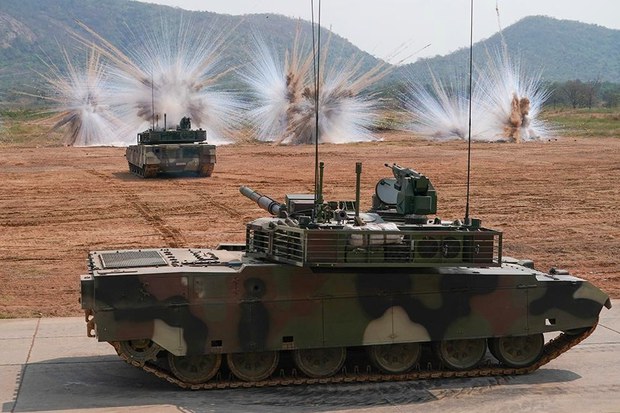Thailand Gets More Tanks, Armored Vehicles from China
2019.12.05
Bangkok
 Thai army VT-4 main battle tanks fire off smoke grenades during a media demonstration at Adisorn Cavalry Center in Saraburi province, northeast of Bangkok, Jan. 26, 2018.
Thai army VT-4 main battle tanks fire off smoke grenades during a media demonstration at Adisorn Cavalry Center in Saraburi province, northeast of Bangkok, Jan. 26, 2018.
Thailand received more battle tanks from China this week, an army official said Thursday, three months after Bangkok took delivery of armored infantry vehicles from the United States.
Ten VT-4 main battle tanks – the final lot of the total of about 50 vehicles – and 38 VN-1 armored personnel carriers, among other military equipment, arrived on Tuesday from China at a port in Chonburi province, southeast of Bangkok, a high-ranking military officer said.
“The tanks and armored cars were brought to the Adisorn Cavalry Center in Saraburi province for inspection,” the officer told BenarNews on condition of anonymity because he was not authorized to speak to the media. He declined to elaborate.
Thailand has not officially confirmed the arrival of its military acquisitions from Beijing, amid domestic criticism over its defense budget despite an economic slowdown.
Bangkok has allocated 233 billion baht (U.S. $7.7 billion) for its security spending for fiscal year 2020, even though the growth rate for Southeast Asia’s second-biggest economy was forecasted by the International Monetary Fund to slow down to 3 percent next year.
The United States froze $4.7 million of security-related aid and cancelled security agreements with Thailand in 2014, when Prime Minister Prayuth Chan-o-cha, then the army chief, led a bloodless putsch that deposed Prime Minister Yingluck Shinawatra.
Washington’s move was a consequence of the U.S. Foreign Assistance Act, a law that bars American security forces from cooperating with nations where an elected government has been toppled through a coup.
But military ties improved after civilian rule was officially restored this year through the Thai general election, which critics said was engineered to keep Prayuth in power.
The latest delivery of battle tanks from Beijing was part of the 50 tanks and auxiliary vehicles ordered in 2016 by the Thai junta from NORINCO, China’s defense corporation, in a deal aimed at replacing M-41 tanks, which were built in the U.S. in the 1950s, Army officials said. The deal was worth about 7 billion baht (U.S. $231 million).
Thailand’s defense equipment from Beijing was delivered as the United States ratcheted up its focus on incentivizing weapons exports to its allies under a new policy aimed at pulling countries under its sphere of influence through long-term arms deals, according to analysts.
As part of its program called Foreign Military Financing, Washington also provides some countries with grants and loans that can be used to purchase defense equipment from U.S. manufacturers. Those grants are separate from arms sales in which the importing country would use its own money to acquire the weapons.
Other than the army hardware, Thailand has also agreed to purchase three submarines worth 36 billion baht ($1.1 billion) from China. Thai officials expect the first delivery in the next five to six years. The Thai junta approved the budget for the first submarine in January 2017 after putting the purchase on hold the previous year as a result of public criticism.
Bangkok has also signed a deal with China Shipbuilding Industry Corp. for a landing platform dock warship, according to ChinaMil, the People’s Liberation Army’s official news website.
As part of Thailand’s modernization effort, Thailand will also purchase from the United States eight Boeing AH-6i attack helicopters and related hardware in a deal worth $400 million. The U.S. State Department approved the sale on Sept. 24.
Thai Army chief Gen. Apirat Kongsompong told reporters in August that about 70 armored personnel carriers would arrive from the United States by the end of this year, with 50 more expected next year. The first batch of 10 arrived in September, local reports said.
The U.S. State Department approved the sale of 60 Strykers in July, in a deal worth $175 million (5.4 billion baht), according to a Pentagon statement.
Analyst: ‘No longer tilting toward China’
Paul Chambers, a lecturer and adviser for international affairs at Naresuan University, said Thailand was expected to even out its arms purchases from the United States and China, despite its early moves gravitating toward Beijing following the 2014 coup.
“I would say that Thailand is no longer tilting toward China but, instead, is pivoting back toward the United States,” Paul told BenarNews. “Nevertheless, I expect the Thai government will seek to balance off the United States and China in terms of foreign policy and arms purchases.”
“In 2019, Thailand is specifically moving closer to the United States in terms of weapons purchases,” he said. “But expect China and the U.S. to both prosper in terms of selling weapons to Thailand.”
Back on Sept. 12, when he led a ceremony accepting the 10 infantry carrier vehicles from the U.S. Army Pacific commander, Gen. Apirat, the Thai army chief, did not directly answer questions from reporters on whether he would prefer U.S. or Chinese weapons.
“Regardless of various sources of weapons, we stick to the American combat value we’ve adopted for 50 years,” he said. “We still use American doctrine we’ve learned.”







